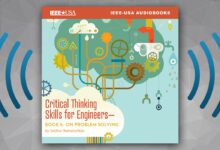
Ever since the Northeast Electric Utility Battery Conference (NEB) dissolved in the mid-1990s, Art Salander dreamed of a new, similar event. With IEEE-USA’s help, the reincarnated conference will return in October as the IEEE NewNEB DC Power Utility Conference & Exhibition.
NewNEB will feature topics of increasing importance to the electric utility industry”large-scale batteries, battery chargers, control systems, diagnostics and testing, and Smart Grid communications”with a special emphasis on backup power and DC power applications.
Industries serving this sector of the power grid have embraced the 7-8 October event at the Clarion Conference Center-Long Island in Ronkonkoma, N.Y. All exhibitor booth space has sold out, but a few exhibitor tables and other sponsorship opportunities are available.
“The reception has been phenomenal,” said Salander, an IEEE senior member electrical engineer who is managing NewNEB. “We have 18 corporate sponsors, and many people have already registered. This particular facet of the DC power industry doesn’t have one single event to call its own, so it’s garnered a lot of interest.”
In addition to the two-day conference of technical papers, panel sessions and keynotes, a battery charger standard meeting will be held on 9 October. The current standard (NEMA PE5) hasn’t been updated since the early 1990s. This effort is directed at creating a new harmonized set of guidelines between IEEE and the National Electrical Manufacturers Association (NEMA). Salander chairs the working group.
“That’s another big part of the event,” he said. “That standard hasn’t been touched in more than 20 years, and when you read through it you can see the antiquity of it. It needs to be fixed, and it needs to be an IEEE standard, which it isn’t right now.
“We are encouraging NEMA to join us in this effort.”
Role of DC Power in Electric Reliability
While most people probably associate alternating current (AC) with electricity, direct current (DC) also plays a key role in the safety and reliability of the electric grid. Major circuit breakers, for one, depend upon battery systems, and DC power is particularly critical when complete power failure occurs.
“The only thing that’s going to get you going in a blackout is battery power,” Salander said. “All switchgear used for transmission and distribution is operated by DC because you need a high slug of energy for a short period of time. So batteries are used for that purpose”for flipping the switchgear”and in generation, they’re used for all kinds of things. Typically in gas turbine applications, it’s the battery system that keeps the turbines hydraulically balanced so you don’t have a mechanical issue.
“Also, all of your control circuits, valve closings and openings and other switching, is all accomplished by battery power. And you want to run it off of direct DC, rather than convert it from AC, because you lose a percentage of power in the conversion.
DC has a number of advantages over AC for these applications.
“DC power is easy to store, you can have a lot of available capacity in a fairly compact area, if you have to, and it’s available to get your [electricity back],” Salander added. “So during a storm, for example, when all the lights go out, and the grid shuts down, it’s the batteries that finally get you going again. That’s why they’re so critically important.
“If the batteries don’t work, you don’t get back on so easily.”
The value of DC power was readily apparent during Superstorm Sandy, which struck the northeastern United States last October, and left about 8.5 million people without power. “Batteries played a very important role in getting people back on board,” Salander said.
Having adopted the theme, Ensuring Ultimate Reliability in a Changing Utility Environment, NewNEB will also look at a proposed standard from the North American Electric Reliability Corporation”PRC-OO5″which includes requirements for battery systems.
“Utilities need to deal with requirement for battery systems, because it all ties to system reliability,” Salander said. “The goal is to find the best way to monitor and ensure reliability of your battery system, so that you ultimately ensure reliability of the transmission and distribution system.”
IEEE-USA’s Role
Salander’s vision of a battery-focused conference began to take shape after he was introduced to IEEE-USA Conferences Committee Chair Charles Rubenstein in October 2011. IEEE-USA, following a few discussions, agreed to become NewNEB’s major sponsor. IEEE Region 1, the Long Island Section, and its Power & Energy Society and Industry Applications Society chapters are cosponsors.
Rubenstein is serving as general conference chair, and 2012 IEEE-USA President Jim Howard is treasurer. Plans are underway to stage the event around the country for at least 10 years.
“IEEE-USA is delighted to pair with a well-known force in the battery standards world, Art Salander, as our conference manager to bring back to life the old Northeast Electric Utility Battery Conference,” Rubenstein said. “NewNEB will bring utility users and suppliers together for forums, exhibits, paper and panel sessions and keynotes, and also provides a venue for NEMA and other standard reviews.”
Salander, who performs engineering and business development work for Easton, Pa.-based HindlePower, can’t wait for NewNEB. He thinks all those working in generation, transmission, distribution, renewable energy and Smart Grid, as well as utility testing, installation and maintenance, will benefit by attending the inaugural gathering.
“This is going to be an active, dynamic conference with a real roadmap to help people solve problems related to our part of the industry,” he said. “With strong support from utility folks”which we’ve already seen”the conference is going to be really successful.”
For more on the IEEE NewNEB DC Power Utility Conference & Exhibition, see www.newneb.org.
Chris McManes is IEEE-USA’s Public Relations Manager.






